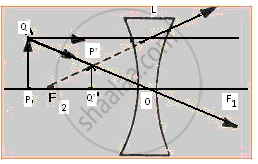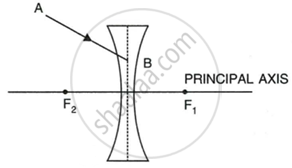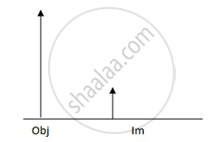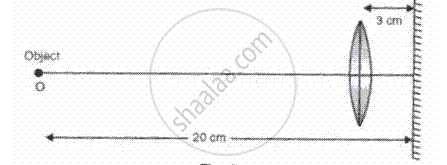Advertisements
Advertisements
Question
Fig shows an object PQ placed on the principle axis of a lens L. The two foci of the kens are F1 and f2. The image formed by the lens is erect, Virtual and dimnished.

(i) Draw the outline ofthe lens L used and Named it.
(ii) Draw a ray of light starting from Q and passing through O. show the same ray after refraction by the lens.
(iii) Draw another ray from Q Which is incident parallel to the principle axis and show how it emerges after refraction from the lens.
(iv) Locate the final image formed.
Solution

(i) Outline of lens is drawn in above diagram. It is a concave lens.
(ii) Shown in diagram above.
(iii) shown in diagram above.
APPEARS IN
RELATED QUESTIONS
Explain optical centre of a lens with the help of proper diagram(s).
In figure, (a) and (b), F1 and F2 are the two foci of thin lenses and AB is the incident ray. Complete the diagram to show the path of the ray AB after refraction through each lens.
 |
| (a) |
 |
| (b) |
A ray of light incident on a lens parallel to its principal axis, after refraction passes through or appears to come from ______.
The diagram given below shows the position of an object OA in relation to a converging lens whose foci are at F1 and F2.

Describe how the distance of the image from the lens and the size of the image change as the object is moved towards F1.
A ray of light incident at the optical centre of lens, passes undeviated after refraction.
(a) Draw a sketch to show how a lens is able to produce an image of the sun on a paper screen.
(b)(i) Would you regard the rays from the sun as being divergent, parallel or convergent?
(ii) What is the name given to the point where such rays meet after they have passed through the lens?
(iii) How does the image of the sun sometimes burn a paper screen?
In the following diagram , the object and the image formed by the respective lenses are shown. Complete the ray diagram, and locate the focus. Find the focal length of the lens.

Make the rrect choices in the following items :
ln fig, , a real image of a point objert O is formed, Which of the following statements is true about each of the arrangements?

(i) The object is at the principle focus of the lens
(ii) The focal length of the lens is 17 cm
(iii) lf the mirror is moved so that it is 6 cm from the lens image will also move
A lens forms the image of an object placed at a distance of 45 cm from it on a screen placed at a distance 90 cm on the other side of it. Name the kind of lens.
When does a ray of light falling on a lens pass through it undeviated?
